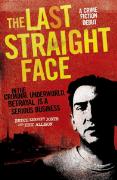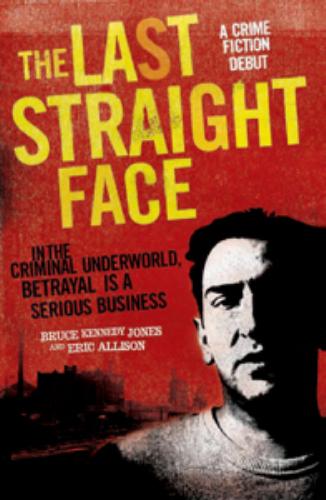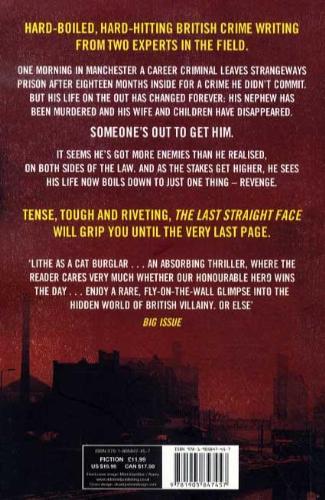|
The Last Straight Face is a
hard-hitting, hard-boiled British crime novel from two experts in the
field.
In begins one morning in Manchester. A career
criminal
leaves Strangeways prison after eighteen months inside for a crime he
didn’t
commit. But his life on the outside has changed forever: his nephew has
been
murdered and his wife and children have disappeared.
Someone’s out to get him.
It seems he’s got more enemies than
he realised, on both sides of the
law. And as the stakes get higher, he sees his life boils down to just
one
thing. Revenge.
SHOTS asked Bruce
Kennedy Jones
and Eric Allison, the authors of The Last Straight Face, to tell us how
their first book came to be written. This is what they sent us. As
it’s so
close to deadline, we’ll have to use it… sadly.
1. They
started The Last Straight Face
while Allison was
in prison. There was the little matter of a million quid
going missing from a bank
account somewhere and the fuzz weren’t overly pleased.
Allison went down for it
and spent some time inside. Visits were reserved for
Allison’s family at first,
so Jones got into the jail by pretending to do a story about a new
project the
prison had started. And lo, Allison was one of the prisoners most
willing to
talk. They were left alone with fags and jelly babies for a couple of
hours,
which gave them time to discuss the book and record an interview for
the story.
2. They
aimed for 1000 words
a week. Each wrote material, and posted it off to the
other. They then talked
again the following week to agree changes.
3. The book
took 23 years to
write. This is not true in real terms. It just felt
like it.
4. The Kray
twins appear in The Last Straight Face. But only
very
briefly and mainly in the hope that Kray aficionados will buy a copy.
5. Their
protagonist is a big
Manchester United fan. This may
encourage United
fans to buy a copy as well. Also ABU (Anyone But United)
non-supporters, if
only to have a go.
6. Some of
the other
characters are based on real villains. Both the
authors have been
around plenty of villains over the years. Allison as a criminal and
Jones as an
investigative hack specialising in crime. And most writing is
autobiographical to
some extent. So there are some real villains in there. And one or two
bits of
real villainy. If pressed, however, the authors would probably prefer
to say
it’s all fiction.
7. They
‘cast’ characters by
looking in Spotlight. Spotlight is the
actors’ directory, with pictures of all
the luvvies in the UK. This was
useful
– with two writers coming at characters from different
directions it helped to
look at photos and at least agree on what they looked like. They
downside was
that volume 2 was missing from Manchester central
library,
so they only looked at male actors with names beginning A-L. The good
news is
that Ray Winstone didn’t get a look in.
8. Raymond
Chandler was a big
influence. But then lots of crime writers say that,
don’t they? Other authors that
led them to this way of life include Elmore Leonard, Ian Rankin and
Patricia
Highsmith, P G Wodehouse, Eric ‘Magic Roundabout’
Thompson, and former How presented
Fred Dineage for his
seminal ghosting of Ronnie Kray’s life story, shrewdly titled
Ronnie Kray: My Story. While writing
the
Last Straight Faces they start 100
odd crime novels and then saw how far they got through them before they
got
bored. Any left standing at the end were dissected for clues on how to
tell
stories and keep readers interested.
9. Lewis
Carroll crops up a
lot in the book.
Specifically Through the Looking
Glass. There are plenty of reasons for this –
Carroll’s looking-glass world
is a place where many of the characters Alice meets are
not as
they first appear. Jacobean and Elizabethan revenge tragedy were also
influences for not-dissimilar reasons.
10. Sixties
cult classic The Prisoner was
another influence. There are
various
reasons for this, which will become more apparent in the sequel, Fat Blackmail. McGoohan’s 17
part series
has been dissected by telly wonks for the last forty years and
they’re still no
closer to working out what it all meant. The
Last Straight Face isn’t so obscure, but there are
shared themes of what it
means to be an individual.
11.
Authenticity was a big
deal. While reading all those books we kept coming
across writers bottling it
when they had to describe a bit of villainous activity. One example had
a
private eye sitting at a house, thinking that his/her lock picking gear
was in
the back of the car, and how he/she might have to pick the front door
later.
Then something happens so he/she doesn’t have to. We say
– harrumph.

The Last
Straight Face
is published by Old Street
June 2008,
£11.99 (Trade Paperback Original)
|






